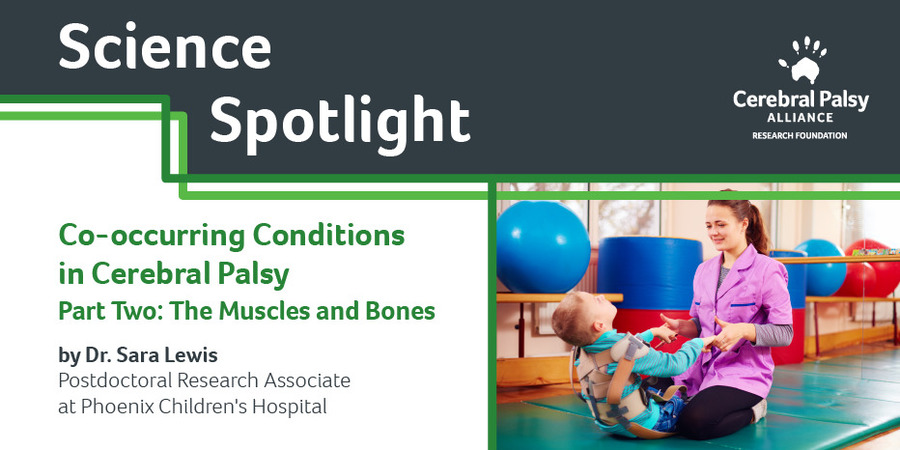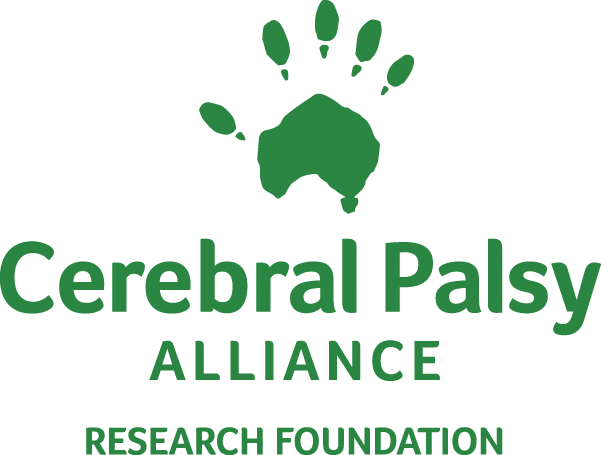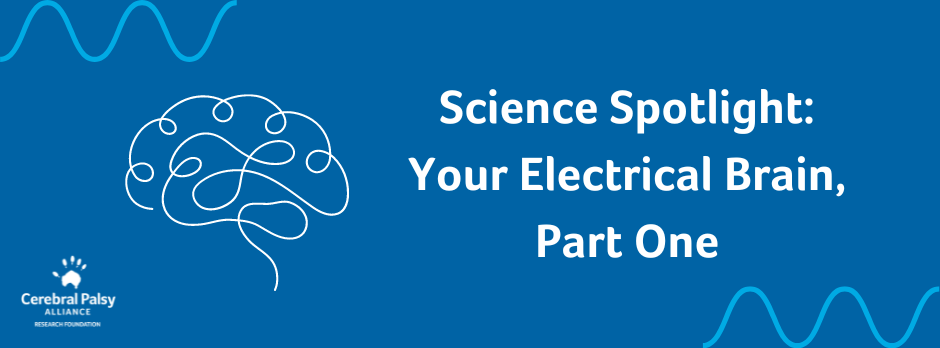
Science Spotlight: Co-occurring Conditions in Cerebral Palsy
Part Two: The Muscles and Bones
By Dr. Sara Lewis
Check out the first part of this series on co-occurring conditions in cerebral palsy focusing on changes in the developing brain.
In cerebral palsy (CP), there are changes to the regulation of the motor neurons — the neurons that activate muscles. These changes include loss of both activating and inhibiting connections to motor and other neurons. In addition to brain changes, muscles and bones are commonly affected, usually due to long-term difficulties with uncontrolled muscle contractions or changes to motor development. This can result in a variety of co-occurring symptoms, making movement even more challenging. For context, the change compared to the rate in the general US population is shown in parentheses when estimates are possible.
One of the most common co-occurring features of CP is pain, which occurs in 75% (7.5 times more common). Pain is most often thought to be due to chronically activated muscles, inflammation and injury from skeletal misalignment, or difficulty changing position with severe disability. However, for some individuals, there may be issues with the nerves that transmit pain signals, suggesting that changes to the nervous system in CP may not be limited to the brain.
A seemingly paradoxical feature of CP is muscle weakness. Why would muscles that are constantly activated be weak? Muscles that are constantly activated can become shortened (contractures). This can increase sarcomere length. Sarcomeres are the functional units of the muscle fiber that slide along its neighbor to generate force and contract the muscle. Longer sarcomeres may ease the strain of constantly contracted muscles by providing fewer contact points for contraction. However, these long-term changes can also create muscle weakness because the muscle units are not capable of generating as much force. This shortening is like having fewer people on your tug of war team, and having less ability to pull when you need to. Other causes of weakness are due to fewer motor neurons available to activate muscles.
In addition to weakness, the muscles of individuals with CP fatigue or tire easily. This is likely due to requiring more energy to complete tasks. This additional energy needed can be caused by the muscles working against each other or not as efficiently as they should. However, this could also happen due to issues with breathing or nutrition preventing the muscles from receiving the necessary fuel. Emotional challenges from disability can also contribute to fatigue.
Non-skeletal muscles — such as the small muscles of the head, diaphragm, and heart — can also be affected.
Within the CP population:
- Speech impairment occurs in 40% to 50%.
- Strabismus — a difficulty in controlling the muscles that move the eye — occurs in 50%.
- Respiratory disease occurs in 30%.
- Cardiac disorders can occur in adulthood, but more studies are needed to estimate this risk.
Changes to the skeleton are also common. For instance, hip displacement may occur because of disruption to the rhythmic contractions of the hip adductor during walking. These contractions are crucial for typical hip development and stability.
- Weakened bones, also known as osteopenia, occurs in 3.5-77%. Inability to move, poor nutritional health, and increased age can increase risk for low bone density.
- Orthopedic disorders such as hip subluxation or dislocation occur in 30%.
- Scoliosis, or spine curvature, is present in 16% (2 times more common).
- foot deformities
The changes associated with cerebral palsy can have long-term consequences on someone’s muscles and skeleton. Skeletal issues seem to be related to the severity of the cerebral palsy, and this suggests that movement affects the development of the alignment of the adult skeleton, and that atypical movements can interfere with this development.
In the final part of this series, we’ll examine co-occurring features of CP that affect other parts of the body.
About the Author: Dr. Sara Lewis is a Postdoctoral Research Associate at Phoenix Children’s Hospital working with Dr. Michael Kruer to identify genetic causes of cerebral palsy. She received her PhD in Neuroscience in 2015 with an emphasis in genetic neurodevelopmental disorders. Her work integrates human genetics with the fly model to study how genes leading to movement disorders changes in the brain. Her work also addresses the challenges implementing genetics findings in the clinical environment. Her research is funded by CPARF.
Articles Referenced:
Hollung SJ, Bakken IJ, Vik T, Lydersen S, Wiik R, Aaberg KM, Andersen GL. Comorbidities in cerebral palsy: a patient registry study. Dev Med Child Neurol. 2020 Jan;62(1):97-103. doi: 10.1111/dmcn.14307. Epub 2019 Jul 4. PMID: 31273772.
Graham HK, Rosenbaum P, Paneth N, Dan B, Lin JP, Damiano DL, Becher JG, Gaebler-Spira D, Colver A, Reddihough DS, Crompton KE, Lieber RL. Cerebral palsy. Nat Rev Dis Primers. 2016 Jan 7;2:15082. doi: 10.1038/nrdp.2015.82. PMID: 27188686; PMCID: PMC9619297.
Whitney DG, Schmidt M, Hurvitz EA. Shared Physiologic Pathways Among Comorbidities for Adults With Cerebral Palsy. Front Neurol. 2021 Oct 4;12:742179. doi: 10.3389/fneur.2021.742179. Erratum in: Front Neurol. 2022 Jan 18;12:830052. PMID: 34671312; PMCID: PMC8520916.
Thu 11 Apr 2024
In the first part of our newest Science Spotlight blog, learn how scientists can harness electricity to help with movement disorders that sometimes accompany cerebral palsy.
Thu 04 Apr 2024
Check out the final part of Rindi and Soren’s story.




